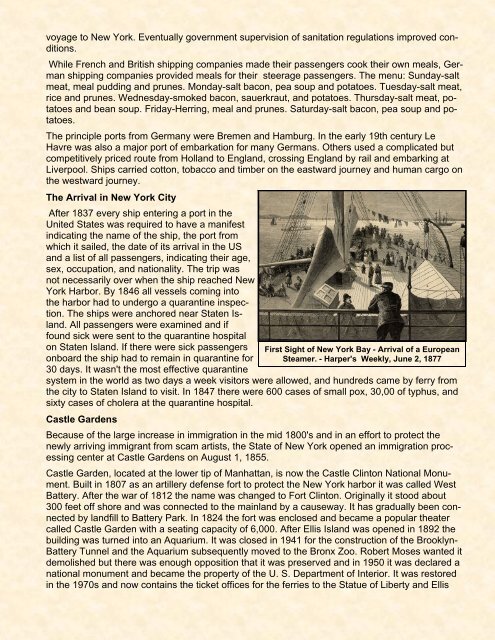Descendants of Levi Infanger - Cardello Family History
Descendants of Levi Infanger - Cardello Family History
Descendants of Levi Infanger - Cardello Family History
Create successful ePaper yourself
Turn your PDF publications into a flip-book with our unique Google optimized e-Paper software.
voyage to New York. Eventually government supervision <strong>of</strong> sanitation regulations improved conditions.<br />
While French and British shipping companies made their passengers cook their own meals, German<br />
shipping companies provided meals for their steerage passengers. The menu: Sunday-salt<br />
meat, meal pudding and prunes. Monday-salt bacon, pea soup and potatoes. Tuesday-salt meat,<br />
rice and prunes. Wednesday-smoked bacon, sauerkraut, and potatoes. Thursday-salt meat, potatoes<br />
and bean soup. Friday-Herring, meal and prunes. Saturday-salt bacon, pea soup and potatoes.<br />
The principle ports from Germany were Bremen and Hamburg. In the early 19th century Le<br />
Havre was also a major port <strong>of</strong> embarkation for many Germans. Others used a complicated but<br />
competitively priced route from Holland to England, crossing England by rail and embarking at<br />
Liverpool. Ships carried cotton, tobacco and timber on the eastward journey and human cargo on<br />
the westward journey.<br />
The Arrival in New York City<br />
After 1837 every ship entering a port in the<br />
United States was required to have a manifest<br />
indicating the name <strong>of</strong> the ship, the port from<br />
which it sailed, the date <strong>of</strong> its arrival in the US<br />
and a list <strong>of</strong> all passengers, indicating their age,<br />
sex, occupation, and nationality. The trip was<br />
not necessarily over when the ship reached New<br />
York Harbor. By 1846 all vessels coming into<br />
the harbor had to undergo a quarantine inspection.<br />
The ships were anchored near Staten Island.<br />
All passengers were examined and if<br />
found sick were sent to the quarantine hospital<br />
on Staten Island. If there were sick passengers<br />
onboard the ship had to remain in quarantine for<br />
30 days. It wasn't the most effective quarantine<br />
First Sight <strong>of</strong> New York Bay - Arrival <strong>of</strong> a European<br />
Steamer. - Harper's Weekly, June 2, 1877<br />
system in the world as two days a week visitors were allowed, and hundreds came by ferry from<br />
the city to Staten Island to visit. In 1847 there were 600 cases <strong>of</strong> small pox, 30,00 <strong>of</strong> typhus, and<br />
sixty cases <strong>of</strong> cholera at the quarantine hospital.<br />
Castle Gardens<br />
Because <strong>of</strong> the large increase in immigration in the mid 1800's and in an effort to protect the<br />
newly arriving immigrant from scam artists, the State <strong>of</strong> New York opened an immigration processing<br />
center at Castle Gardens on August 1, 1855.<br />
Castle Garden, located at the lower tip <strong>of</strong> Manhattan, is now the Castle Clinton National Monument.<br />
Built in 1807 as an artillery defense fort to protect the New York harbor it was called West<br />
Battery. After the war <strong>of</strong> 1812 the name was changed to Fort Clinton. Originally it stood about<br />
300 feet <strong>of</strong>f shore and was connected to the mainland by a causeway. It has gradually been connected<br />
by landfill to Battery Park. In 1824 the fort was enclosed and became a popular theater<br />
called Castle Garden with a seating capacity <strong>of</strong> 6,000. After Ellis Island was opened in 1892 the<br />
building was turned into an Aquarium. It was closed in 1941 for the construction <strong>of</strong> the Brooklyn-<br />
Battery Tunnel and the Aquarium subsequently moved to the Bronx Zoo. Robert Moses wanted it<br />
demolished but there was enough opposition that it was preserved and in 1950 it was declared a<br />
national monument and became the property <strong>of</strong> the U. S. Department <strong>of</strong> Interior. It was restored<br />
in the 1970s and now contains the ticket <strong>of</strong>fices for the ferries to the Statue <strong>of</strong> Liberty and Ellis




